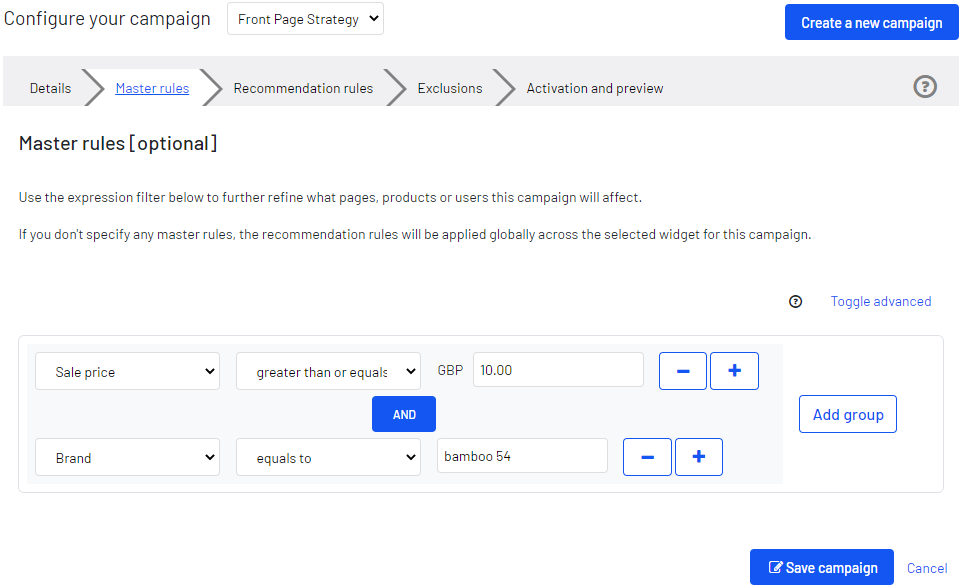 Defining Product Recommendations master rules
Defining Product Recommendations master rules
Setting up Master rules is optional.
Master rules let you refine the Product Recommendations campaign Personalization: Describes rules for displaying recommendations that share a strategy and time frame while marketing a product or service. effects to pages, products, or visitors Someone who visits a website using a web browser. In most cases, a visitor can use public functions and services but cannot create content and has limited access to community content. In an SEO context, visitor means the number of visits to a URL through channels (external referrers), direct arrivals, and internal links. (See also visitor groups.). If you do not specify any master rules, the merchandising rules are applied globally across the selected widget Configurable screen element that displays information. for a campaign. If you apply a Master rule, it must be satisfied to apply product recommendation rules.
A master rule lets you define where the rule will work. For example:
- If you setup a master rule that states r.category="category A", the campaign operates only on category A; other categories will not apply the campaign.
- If you do not define a master rule (a master rule is not required) then the campaign applies to every instance of that widget. For example, if you setup a campaign on the category widget, the campaign applies to every category page, such as category A, B, C, ... Z.
For example, you may have one product recommendation rule that recommends products that are over $50, and another rule that recommends products only from Brand X. You can set a Master rule that lets only products that have at least 10 items in stock be displayed (for either the over $50 rule, or the Brand X rule).
Examples of Master rules frequently used:
| Use case | Master rule |
|---|---|
| Recommend only products from the same brand as the current product being viewed. | Brand equals to and type the brand name in the Search field. |
| Recommend a specific product SKU when a specific product is viewed (that is override with a hand-picked product). | Ref Codes equals to and type the product SKU. |
| Only recommend products above a specific price when a user is viewing a product above a certain price. | Sale Price greater than or equals and type in the price (such as 25). |
| Do not recommend discounted products when a user is viewing a full priced product. | Discount equals to False. |
- To add a Master rule, select the product attribute for your products from the drop-down list. The attributes are based on the product feed A file made of all products a client sells. Each product contains an image link, title, identifier, URL, price, currency, and optional attributes., plus a few attributes that Optimizely creates by default. If you do not see the attribute that you want, add it to your product feed.
- Select the condition you want in your rule. For attributes that have a text value, such as Color or Brand, choose between equals to or NOT equals to. For attributes with a numeric value, such as Sale price or Unit price, you also can use comparison operators like greater than or less than.
- In the text field, enter the value of the attribute to be evaluated. For most attributes, a drop-down list shows values when you click in the text field. You also can start typing in the box to filter the results. Click a value to select it. Numeric values (such as prices) do not have a pre-populated list; enter the value manually.

You can add multiple rules by clicking the Add group or +. When using multiple rules you can choose how you want them to interact by setting the AND or OR operator.
To remove a rule, click minus - next to it.